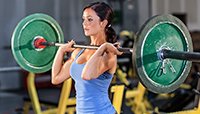Look at a bodybuilder or powerlifter: Who doesn't want to be powerful!? While you may have a general idea as to what that means—perhaps a gorilla's beastlike strength, a monster truck, or maybe Benny deadlifting a grand—in fact power has a more precise definition. What does "power" mean and how do you develop it? Let's take a look.
If you remember from your high school physics class—you did take that, right?—power is expressed as equal to force times distance over time (P=(F x D)/T). To further confuse you, force is created by a factor of acceleration times mass (F=MA). These equations prove that weight alone isn't the only factor in play; so are speed (how fast you accelerate), distance, and time. Hence, training for power encompasses all these variables. To be clear, training for power isn't the same as training for strength.
Any change in the force produced, distance moved, or the time it took you to move a given load will lead to an increase in power production. It's not just about moving heavy weight!
Intelligent lifters looking for greater power must incorporate these 7 principles of power.
1
ABSOLUTE STRENGTH
Maximal strength might be the most obvious trait to develop for power development; clearly it's the most beneficial and recognizable feature. Many lifters will recognize this concept in their maximal effort training used to develop absolute strength.
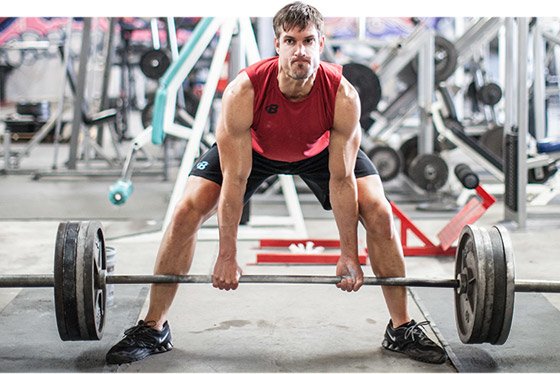
We could define absolute strength as the maximum amount of force an athlete can apply with his body or the maximum amount of force that can be produced in a particular muscular contraction. This trait is primarily developed through training with loads that are above 90 percent of your one-rep max. The core concept behind absolute strength is motor unit recruitment.
Training to increase strength (typically with heavy loads for fewer reps) is distinct from training for size (moderate loads for moderate reps), though you'll get some size benefits with strength training. The number of firing motor units is also affected by the load. While bodybuilders usually take sets to failure to exhaust a muscle, that's not the case when training for strength. All these variables make strength training distinct and allow you to tailor your training efforts to focus on this building absolute strength.
2
DYNAMIC STRENGTH
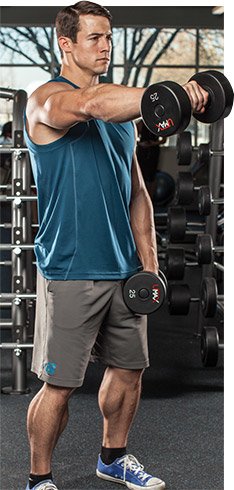
This might be better described as speed strength, learning to move heavy weights quickly. Dynamic refers to the speed at which force can be produced, rather than sheer force alone. Some athletic movements (gymnastics, shot put, jumping, etc.) require this type of speed, as do some moves in the weight room (Olympic weightlifting, box jumps).
Speed strength trains rate of force development and could be the most important athletic trait to consider. I In the previous section we were concerned with the overall number of motor units recruited, now we are trying to recruit those motor units earlier and faster.
Dynamic strength is best developed with moderate loads moved at a maximum velocity. Remember that power—or force—is the product of mass (absolute strength) and velocity (speed strength); these are the two pillars your development must rest on. Absolute strength is trained with heavy slow-moving loads; speed strength is trained with light or moderate loads moved fast. That's a critical difference.
Intensities are best programmed in the 40-60 percent range, so these loads are relatively light. Still, repetitions should still be kept low, usually in the 2-3 rep range. To increase volume, add more sets rather than adding reps (12 sets of 3 instead of 4 sets of 9). Move these loads as fast as you can. If you lift 500 pounds and are training with 250 pounds, apply your full throttle 500 pounds to that bar and rock it.
3
PLYOMETRICS
While plyometrics are reliant on speed strength, a primary principle that differentiates them from dynamic effort methods is the emphasis on the stretch-shortening cycle at the beginning of each rep. Think of your muscles as a rubber band. Before you can shoot that rubber band at someone, you first have to stretch it. While not a perfect analogy, lengthening muscles deep into an eccentric motion stores potential elastic energy. This is why your first rep on dumbbell bench presses is often the most difficult: You start with the weight in the down position, and that first rep has no elastic energy built up. To apply power in plyometrics, the joint angle is then reversed as quickly as possible.
Frequently, focus is given to the eccentric (negative, or lowering) phase of the movement. The force the muscle produces depends on the speed of shortening or lengthening and the absolute length of the muscles at any instant in time. In eccentric exercise, force increases as the velocity of stretch increases.
The faster the transition from eccentric to concentric occurs, the greater the muscular contraction produced and the greater overall power. Jumps, clapping push-ups, bounds, throws, and hops are all effective plyometric movements to train you to move quickly.
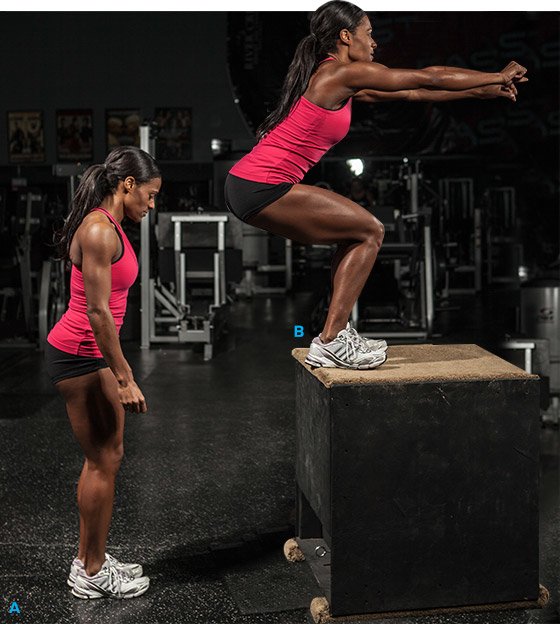
Bodybuilders may lift slowly to maximize hypertrophy, but for athletes or people seeking power development, lifting slowly isn't going to cut it. If you want to add some "go" to your "show" include plyo in your training. It will go a long way to keeping those growing muscles fast and athletic.
The general consensus is that movements which require higher skill and neurological activity be done early in your training session. While some plyo or Olympic lifts won't prevent you from making your strength or hypertrophy gains—if anything, they'll help—fatiguing motor units prior to explosive training may hinder your ability to improve power production. My regular recommendation for strength athletes is to include 1-2 plyometric movements immediately after warm-ups, just prior to the performance of major strength movements. This will not only further warm-up goals, but will also improve nerve-muscle reactions and your ability to produce force in your primary strength movement. Select plyometrics movements that are applicable to that training day, such as depth jumps for squat day, throws for pressing, etc.
4
DEAD-STOP TRAINING
While there are times you want to change direction as fast as possible at the bottom of a rep (see plyometrics above), dead-stop training does the exact opposite. To completely eliminate the elastic energy created by the stretch reflex, come to a complete stop at the bottom of the rep. This is precisely how deadlifts are done when the bar settles on the ground at the start of each rep. That makes the beginning of the movement harder than it would've been. If the bottom of the range of motion is a weak area—such as the bottom of a bench press when the bar is just off your chest—then you'll want to focus on strengthening this portion of the lift, and that's what you can do with dead-stop training.
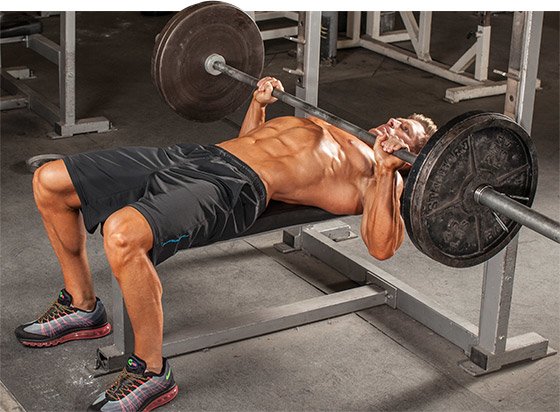
Applied to the bench press, the weight starts at chest level instead of being lowered from the top. You'll need to be in the power rack for this movement. Set the pins so the bar will be just above the chest. Starting from the bottom eliminates some of that stretch reflex, helping you get significantly stronger in the bottom position. You can adjust the height of the pins to work through sticking points or to progressively bring down a heavier weight (this is great for squats, too).
You'll want to be using the power rack (some Smith machines allow you to set the bottom of the range of motion, too) on these movements so a weight can settle between reps. Alternatively, holding the bottom position for a long count between reps also reduces the stretch reflex.
5
ACCOMMODATING RESISTANCE
As you normally perform your movement, the bar speed increases; you're typically a little stronger over the middle of the rep. This makes training a little one-dimensional. Adding bands and chains to the bar creates contrasting, variable resistance; this helps you overcome accommodation.
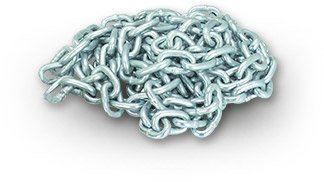
Bands and chains work in a similar way. At the bottom of the movement the load is lighter—the bands aren't stretched or the chains are settled on the floor. As you drive through the concentric phase of the lift, they increase the resistance so the weight becomes heavier toward the top. This increased weight strengthens your lockout and teaches you to accelerate. Bands and chains can be used for both heavy and light work.
Use 5/8-inch chains folded in half and attached to a 1/4-inch leader chain that's suspended from the bar. Adjust the leader so that a link or two touches the floor at the top of the movement. For most people 1-2 chains are sufficient.
Bands come in two sizes. Short bands are ideal for benches and deadlifts, while long bands can be used for anything. Both come in a range of resistances, from 30 to more than 200 pounds. Make sure the bands are securely anchored, and—with long bands—play with the setup until you have adequate tension both at the bottom and top. There should be no slack in the bands at any time.
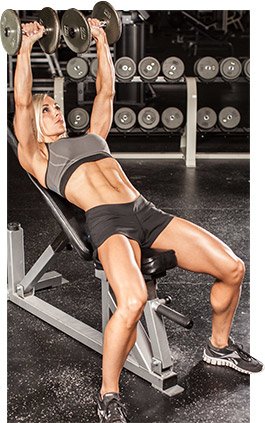
6
STABILITY
The more stable you are, the more power you'll be able to express.
There was a wave of popularity for a while for training in an unstable environment, such as on a ball or on one leg, though thankfully it's falling out of practice. While there are some applications for such techniques, they do little to help you become more powerful. Such techniques are great for core building but come at the expense of power, strength and size development. Moving heavy loads requires you to be stabilized, and any energy "leak" in your system, lack of tightness in any area, or any instability will radically decrease the amount of force you're able to transmit to the bar.
Imagine your bench press. Many trainees can be seen lying back on an exercise ball, a habit that's about as effective as firing a cannon out of a canoe. Did you know that many strong powerlifters get sore lats from bench pressing? That is how tight they are. From the grip on the bar, to retracted shoulder blades, through the hips, and down the legs that are driving down into the floor, the entire system is set up to provide stability to the load being moved.
Whatever the lift is, you should be solid as a rock. You'll have whatever part of you is touching the floor to push against, maybe a bench, even a belt, but much of your stability will have to come from you being properly positioned and keeping muscles tight.
7
APPLICATION OF SKILL + TECHNIQUE
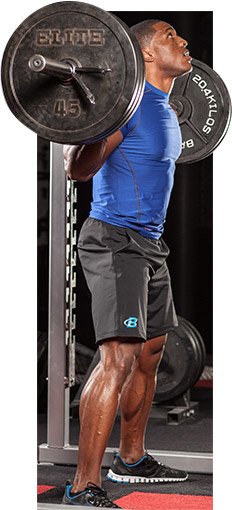
Lifting is a skill, though many don't see it that way. Through training hard, I squatted 400 pounds. Good programming brought me to 500. However, my subsequent jumps to 600 and then 700 would've been impossible without a heavy emphasis on technique. I frequently compare lifting skills to the golf swing. Mark Bell (an 800-plus bencher) can be witnessed carefully setting up and doing reps with the empty bar; to understand this watch Phil Mickelson take a few practice swings before teeing off. Both athletes are practicing the skill involved with their sport.
Ultimately, there isn't an easy, practical training tip to give here like in the other six sections. Despite that, this may be the most valuable advice in the whole piece. I'm constantly amazed at people who make a living in this industry who know little about lifting.
Be a student, absorb knowledge, and study. High-level power will be impossible without continuous learning. How does bar position affect torso angle in the squat? Should the bar path in a bench press move in an arc or a straight line? Why are my knees caving in? These simple questions and answers are absolutely vital to good technique. Ensuring you know the answers will go a long way to increasing your power output.
Recommended For You
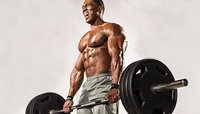
Using Multiple Rep Schemes: Your Program For Power, Size, And Strength
Everybody has more than one fitness goal, but not everybody knows how to go after more than one goal at a time. Here's the perfect program that utilizes multiple rep schemes so you can build power, size, and strength at once!
Keep The Weights Moving Up: Two Foolproof Progressive Overload Plans
Lifters of all levels can feel at times like they've reached their strength ceiling. Don't believe it! Learn progressive overloading techniques that bust through walls of weight.